
In Conversation: Yamini Yagnamurthy!
Sep 05 2024
Yamini Yagnamurthy, acclaimed for her innovative visual storytelling in films like Sillu Karupatti and Sanikayidham, brings her signature style to the period comedy-drama Raghu Thatha. Directed by Suman Kumar and produced by Hombale Films, Yamini’s cinematography adds depth and character to this unique narrative.
In conversation with Cinematographer Yamini Yagnamurthy

Yamini, you’ve become known for your distinctive visual storytelling. Could you share with us how your journey into cinematography began?
My passion for cinematography really took shape during my second year of B.Sc. Visual Communication. It was at that point I realized that cinematography was not just an interest but the career path I wanted to pursue wholeheartedly. To support myself financially while I worked towards this goal, I delved into portrait and commercial food photography. It was important for me to become financially independent, especially while working as an assistant, so I could continue learning and growing in my field without any financial constraints.
You had the opportunity to work with the legendary P.C. Sreeram. How did that experience influence your career?
Working under P.C. Sreeram sir was a pivotal experience in my career. He’s a visionary, and learning from him opened up new perspectives on visual storytelling and the technical aspects of cinematography. His approach to lighting, composition, and the overall visual narrative left a lasting impact on me. It was during this mentorship that I truly understood the power of visual language in filmmaking, and it gave me the confidence to explore and experiment with my own style.
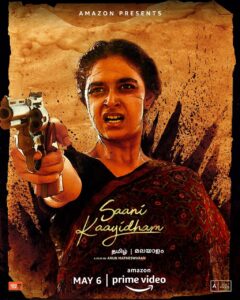
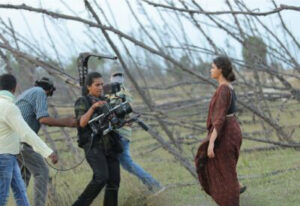
Your second feature film Saani Kaayidham is noted for its raw and intense visual style, particularly with the use of handheld cameras. Can you share your approach to cinematography for this film and why you chose to go handheld?
Saani Kaakiidham was a physically demanding project, and the handheld approach was central to capturing the film’s raw and gritty atmosphere. From the outset, I wanted the audience to feel the intensity and immediacy of the story, and handheld cameras allowed me to achieve that. The constant movement, the slight imperfections, and the closeness of the camera all contributed to a sense of unease and urgency that mirrored the narrative.
Initially, the handheld approach was challenging, especially with the film’s relentless pace and the weight of the camera. However, as the shoot progressed, I embraced it fully, and it became an integral part of the film’s visual language. The handheld technique, combined with a limited color palette and rustic tones, helped us convey the harsh realities of the characters’ lives. The camera’s unsteady movement added a layer of authenticity, making the audience feel as though they were right there with the characters, experiencing every moment of their journey.
Let’s talk about your latest project, Raghu Thatha. What was your vision for the film, especially considering it’s a period comedy-drama?
Raghu Thatha is set during a significant political era in Tamil Nadu and features a small-town backdrop, so I wanted the visuals to be vibrant and reflective of that period. The film had more characters and a broader color palette compared to my previous projects. My vision was to connect the audience with the natural environment of that era, so I incorporated greens and blues into the visual scheme, which also helped to soften the overall tone and avoid a conventional dramatic feel.
In terms of aesthetics, I drew inspiration from the vibrant color schemes seen in Shivaji-era films. To achieve this, I chose Cooke Panchro Classic lenses, which provided a unique vintage warmth and allowed for soft, yet contrast-rich shadows. These lenses were crucial in bringing out the rich, pigmented colors that were central to the film’s period setting.
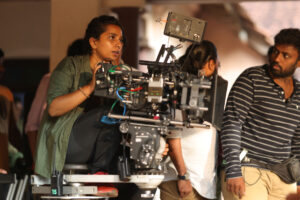
You mentioned that Raghu Thatha featured more characters and colors in each frame. How did that affect your approach to cinematography?
With more characters and a richer color palette, it was essential to maintain visual clarity and avoid overwhelming the audience. I focused on creating a sense of connection with nature through the use of greens and blues, which helped anchor the audience within the setting. Managing the colors and characters within each frame was a challenge, but it was also an opportunity to explore more dynamic compositions and lighting schemes.
Lighting plays a crucial role in period films. How did you approach the lighting design for Raghu Thatha?
For Raghu Thatha, I wanted to break away from the typical soft, diffused lighting often seen in period dramas. Instead, I opted for specular lighting, using hard light sources to create natural shadows and enhance the authenticity of the period. Even the moonlight was treated as a hard source, casting distinct shadows that added depth to the scenes.
One of the challenges we faced was working with interiors that had low ceilings, which caused extra light to spill onto the background. To manage this, I focused on achieving greater separation between the actors and the background during the shoot itself. I knew that some of the spill light would be corrected in post-production during the DI (Digital Intermediate) process, but I wanted to ensure that the initial footage was as close to my vision as possible.

Could you elaborate on your choice of lenses and how they contributed to the overall visual style of the film?
The choice of lenses was integral to achieving the visual style I envisioned for Raghu Thatha. I chose the Cooke Panchro Classic lenses because of their vintage warmth and their ability to create a soft, yet contrast-rich image. These lenses were particularly effective in rendering the pigmented colors in the highlights, which was essential for capturing the vibrant period look we were aiming for.
As the shoot progressed, I discovered more characteristics of these lenses, particularly how they handled shadows and the fall-off of light. They provided a beautiful, filmic quality that complemented the era we were portraying. For composition, I primarily used wider lenses, particularly the 25mm and 35mm, which allowed me to capture the expansive setting and the richness of the period detail in each frame.
Aspect ratio is an important consideration in filmmaking. How did you approach this for Raghu Thatha, especially with both theatrical and OTT releases in mind?
Aspect ratio was a significant consideration for Raghu Thatha because we wanted to ensure that the film’s visual impact was consistent across both theatrical and OTT platforms. We primarily shot for a 1:2.35 aspect ratio, which is standard for theatrical release, but we also composed certain segments in a 1:1.33 ratio. For the OTT release, we adapted the composition to a 1:2.1 ratio. This approach allowed us to maintain the film’s integrity while making sure it translated well on different viewing platforms.
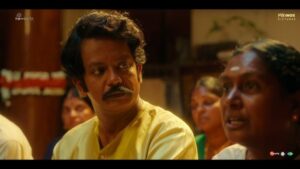
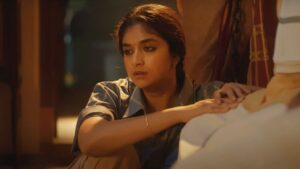
Lastly, how would you describe your overall experience working on a period comedy-drama film
Working on this film was an incredibly fulfilling experience. Blending the elements of a comedy with a period setting presented unique challenges, but it also allowed me to explore new techniques and push the boundaries of my craft. The opportunity to work with an amazing crew, experiment with lighting and lenses, and bring a vibrant historical era to life on screen was both challenging and deeply satisfying. This project truly reinforced my passion for cinematography and storytelling.
Article by
CJ Rajkumar
Author/ Cinematigrapher
